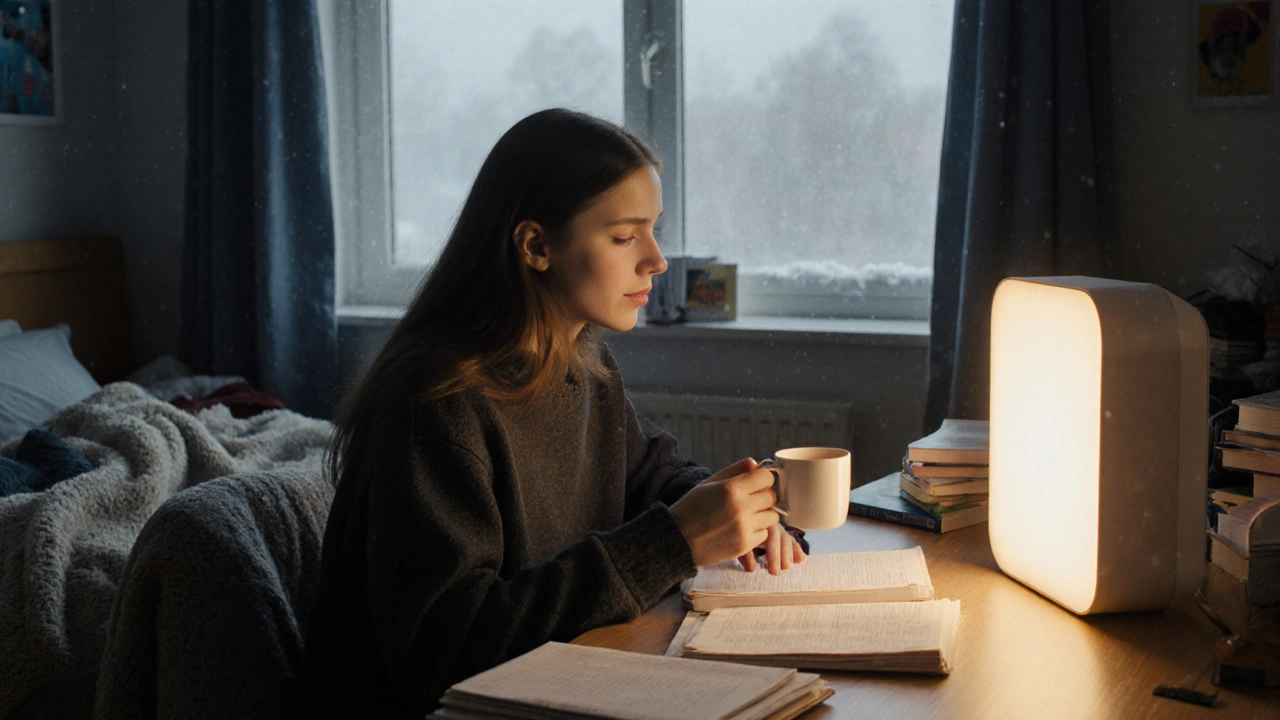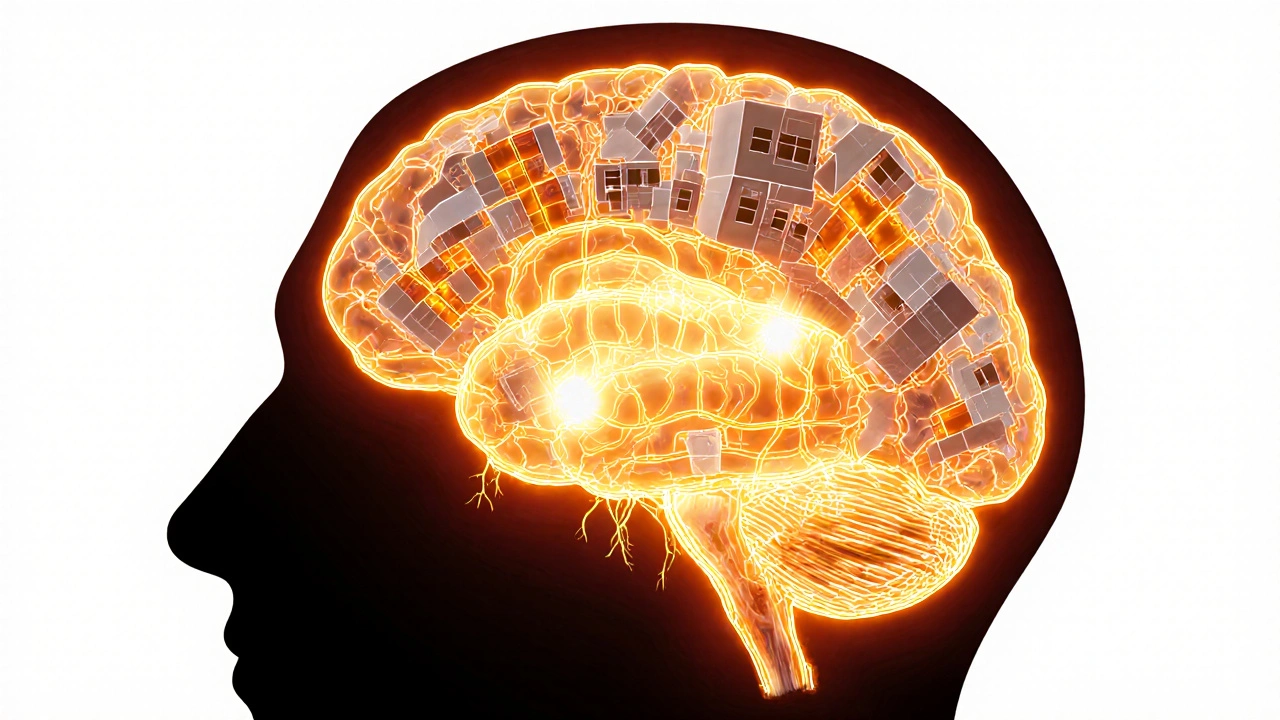
Every year in late October, as the days get shorter and the sky stays gray well into afternoon, students across UK universities start feeling off. Not just tired-actually heavy. Like their body’s running on low battery, even when they’ve slept eight hours. They skip meals, cancel plans, and struggle to get out of bed. It’s not laziness. It’s seasonal affective disorder, or SAD-a real, biologically driven form of depression tied to the lack of natural light in winter.
What Seasonal Affective Disorder Really Feels Like on Campus
SAD isn’t just "feeling down in winter." It’s a clinical condition recognized by the NHS and supported by research from the University of Oxford. Students with SAD report crushing fatigue, difficulty concentrating in lectures, increased appetite-especially for carbs-and weight gain. Some lose interest in hobbies they used to love. Others feel socially withdrawn, avoiding group work or even texting friends.
At universities in Scotland, northern England, and even London, the problem spikes between November and February. A 2024 survey of over 12,000 UK university students found that 37% experienced moderate to severe SAD symptoms. That’s nearly four in ten. And it’s not just international students adjusting to colder weather-native students feel it too. The brain’s production of serotonin drops. Melatonin levels stay high, making you sleepy even when it’s not bedtime. Your body thinks it’s still hibernating.
Light Is Your Most Powerful Tool-Here’s How to Use It
The most effective, science-backed treatment for SAD is light therapy. Not just sitting by a window. You need a special light box that mimics natural daylight. Look for one that delivers 10,000 lux of full-spectrum light, with UV filters to protect your eyes. Use it for 30 minutes each morning, ideally within an hour of waking up.
Many UK universities now offer free light therapy boxes through student health services. Durham, Edinburgh, and Manchester all have loan programs. You don’t need a prescription-just book one online. Place it on your desk while you eat breakfast or read. Don’t stare at it-just let the light hit your face while you do normal things. Studies show this can lift mood in as little as three days.
Outside, even on cloudy days, natural light is still stronger than any indoor bulb. Try to get outside for at least 20 minutes before noon. Walk to class. Sit in the quad. Skip the elevator and take the stairs. Your eyes need that exposure to reset your circadian rhythm. One student at Leeds told me she started walking to the library instead of taking the bus-and her energy improved within a week.
Routine Isn’t Just for Productivity-It’s for Your Brain
When you’re depressed, your day starts to collapse. You sleep in. You skip breakfast. You eat junk food at 2 a.m. Then you feel worse. This cycle makes SAD worse.
Sticking to a routine doesn’t mean being rigid. It means creating anchors. Wake up at the same time every day-even on weekends. Eat breakfast within an hour of waking. Get sunlight before 10 a.m. Eat dinner at a consistent time. Go to bed at the same hour. These aren’t tips for overachievers-they’re biological necessities for your brain.
Research from King’s College London found that students who maintained a consistent sleep-wake schedule reduced their SAD symptoms by 52% over eight weeks. Even small shifts matter. If you normally wake up at noon, try 11 a.m. Then 10:30. Don’t try to change everything at once. Pick one anchor-maybe breakfast-and stick to it for a week. Then add another.

What Doesn’t Work (And Why)
Some students try caffeine to fight fatigue. It backfires. You crash harder later. Others turn to alcohol to "relax." It disrupts sleep and lowers serotonin. Vitamin D supplements help some people, but they’re not a fix on their own. A 2023 meta-analysis in the British Journal of Psychiatry showed vitamin D only improved SAD symptoms when combined with light therapy.
And don’t wait for spring. SAD doesn’t get better if you ignore it. The longer you wait, the more your brain gets stuck in the pattern. Early intervention is key. If you’re feeling low in November, don’t tell yourself you’ll be fine in January. Start now.
What Your University Should Be Doing (And Often Isn’t)
Most UK universities have mental health services-but they’re overwhelmed. Waiting lists for counseling can be weeks long. But SAD is preventable. Universities need to make light therapy easy, not optional.
Some schools are stepping up. The University of Glasgow installed light panels in common areas and dorm lounges. Sheffield Hallam offers weekly SAD workshops with campus nurses. Cardiff University now includes SAD awareness in first-year orientation.
But too many still treat it like a personal issue. It’s not. It’s a public health issue tied to geography and season. If your university doesn’t offer light boxes, ask for them. Email student union reps. Bring up SAD in feedback surveys. You’re not asking for special treatment-you’re asking for a basic health resource that’s proven to work.

When to Get Help Beyond Light and Routine
Light therapy and routine fix most cases. But if you’re having thoughts of hopelessness, can’t get out of bed for days, or have lost interest in everything-even food or hygiene-it’s time to talk to someone.
Every UK university has a student counseling service. You don’t need to be in crisis to use it. Many offer drop-in hours, and some have SAD-specific support groups. Cognitive behavioral therapy (CBT) tailored for seasonal depression has been shown to be as effective as medication in long-term studies.
Medication like SSRIs can help, but they’re not the first step. Talk to your GP or campus nurse. They can help you decide if it’s right for you. The goal isn’t to medicate your way through winter-it’s to get your body back on track so you don’t need it.
Real Students, Real Changes
Emma, 20, from Birmingham, started university in Dundee. She’d never experienced winter like that. By December, she was sleeping 12 hours a day and skipping classes. She borrowed a light box from student services. She started walking to her morning lecture instead of taking the bus. She set a 7:30 a.m. alarm and ate breakfast every day-even if she wasn’t hungry.
By January, she was back in class. By February, she joined a campus hiking group. "It wasn’t magic," she said. "It was just doing the same small things every day. My brain started trusting that the light was coming back."
James, 21, from London, used to think SAD was an excuse. Then he felt it himself. He started using his phone’s sunlight tracker app to see how much natural light he got each day. He noticed he was getting less than 15 minutes before noon-way below the 30-minute minimum experts recommend. He bought a cheap LED desk lamp (10,000 lux, under £50) and used it while doing his readings. His mood lifted. His grades improved.
These aren’t outliers. They’re students who took back control-by understanding how light and routine shape their biology.
What to Do Today
You don’t need to fix everything tomorrow. Start with one thing:
- Check if your university offers free light therapy boxes. Book one today.
- Set your alarm 30 minutes earlier than usual. Don’t hit snooze.
- Go outside for 20 minutes before noon-even if it’s cloudy.
- Eat breakfast within an hour of waking. Even toast and tea counts.
- Write down your bedtime and wake-up time for the next three days. Stick to it.
These aren’t chores. They’re repairs. Your brain needs light like your body needs water. Routine is the structure that holds you up when the dark days come.
Winter isn’t coming. It’s already here. But you don’t have to wait for spring to feel better.
Is seasonal affective disorder the same as the winter blues?
No. The winter blues are mild and short-lived-maybe you feel a bit sluggish or less social. SAD is a clinical diagnosis. It lasts for weeks, interferes with daily life, and often includes symptoms like extreme fatigue, oversleeping, weight gain, and difficulty concentrating. If it’s affecting your studies, relationships, or ability to get out of bed, it’s likely SAD, not just the blues.
Do I need a doctor’s note to get a light therapy box from my university?
No. Most UK universities provide light therapy boxes through student health or welfare services as a preventive tool. You don’t need a diagnosis or referral. Just visit your student union office or mental health portal and request one. Some even deliver them to your dorm.
Can I use a regular bright lamp instead of a light therapy box?
Not effectively. Regular lamps don’t provide the right intensity or spectrum of light. You need at least 10,000 lux of full-spectrum, UV-filtered light, delivered at the right distance and angle. A standard desk lamp might give you 500 lux-too weak to trigger the biological response your brain needs. Look for a box labeled "10,000 lux SAD light therapy device."
How long does it take for light therapy to work?
Most people notice a difference in 3 to 7 days. Some feel better in 24 hours. Consistency matters more than duration-using the light box for 30 minutes every morning is more effective than two hours once a week. Stick with it for at least two weeks before deciding if it’s working.
Should I take vitamin D supplements for SAD?
Vitamin D can help, but it’s not a standalone solution. Low vitamin D levels are common in winter, and supplementing may improve mood slightly. But research shows it only works well when combined with light therapy. If you’re unsure, ask your campus nurse for a blood test. Don’t rely on supplements alone-they won’t fix your circadian rhythm.
Can SAD affect my grades?
Yes. SAD can reduce concentration, memory, and motivation-all critical for studying. Students with untreated SAD are more likely to miss deadlines, skip classes, and perform below their ability. Many universities offer extensions or academic accommodations for documented mental health conditions. If SAD is impacting your work, contact your student support team. You’re not alone, and help is available.
If you’re feeling overwhelmed, reach out. Your mental health matters as much as your grades. You don’t have to power through the dark. There are tools. They work. And you deserve to feel like yourself again-even in winter.